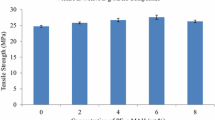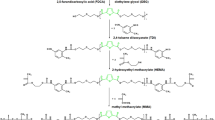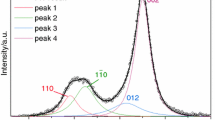Abstract
In the present work, a terpolymer of acrylamide–formaldehyde–urea (AMFU) which could interact with both plant fiber and high density polyethylene (HDPE) was synthesized, and which as novel compatibilizer for HDPE/plant fiber was also investigated. The result of SEM demonstrated that interfacial adhesion was observed in the presence of AMFU compatibilizer but void at the interface of HDPE/plant fiber without compatibilizer. Evident improvements on both static and dynamic mechanical property of WPC in the presence of AMFU compatibilizer were observed. Water uptake indicated that WPC with AMFU compatibilizer shown a lower water uptake. This research gives a new way in the design of new compatibilizer for WPC in the future.





Similar content being viewed by others
References
Craig C (2002) Wood–plastic composite in the United States. For Prod J 52:10–18
Susan S, Indrek W (2004) Wood fiber/polyolefin composites. Composites A 35:321–326
Ashori A (2008) Wood–plastic composites as promising green-composites for automotive industries. Bioresour Technol 99:4661–4667
Lu JZ, Wu QL, McNabb HS (2000) Chemical coupling in wood fiber and polymer composites: a review of coupling agents and treatments. Wood Fiber Sci 32:88–104
Zhang C, Li K, Simonsen J (2006) Terminally functionalized polyethylenes as compatibilizers for wood–polyethylene composites. Polym Sci Eng 46:108–113
Djiporovic M, Dingova E, Miljkovic J, Popov-Pergal K (2003) The influence of different coupling agents on some properties of polypropylene–wood composites. Mater Sci Forum 413:219–224
Qiu W, Zhang F, Endo T (2005) Effect of maleated polypropylene on the performance of polypropylene/cellulose composite. Polym Compos 26:448–453
Pickering KL, Ji C (2004) The effect of poly [methylene (polyphenyl isocyanate)] and maleated polypropylene coupling agents on New Zealand radiata pine fiber–polypropylene composites. J Reinf Plast Compos 23:2011–2024
Geng Y, Li K, Simonsen J (2004) Effects of a new compatibilizer system on the flexural properties of wood-polyethylene composites. J Appl Polym Sci 91:3667–3672
Geng Y, Li K, Simonsen J (2006) Further investigation of polyaminoamide epichlorohydrin-stearic anhydride compatiblizer system for wood–polyethylene composites. J Appl Polym Sci 99:712–718
Acknowledgments
The authors acknowledge financial support of Foundation of Nanjing Forestry University (163020051), Research Plan of the Natural Science of Jiangsu General University (07KJA22018) and National Science Foundation of China (31070492).
Author information
Authors and Affiliations
Corresponding author
Rights and permissions
About this article
Cite this article
Cui, J., Mei, C., Jia, C. et al. Acrylamide–formaldehyde–urea copolymer as a novel compatibilizer for high density polyethylene/plant fiber composite. Polym. Bull. 67, 375–382 (2011). https://doi.org/10.1007/s00289-010-0384-9
Received:
Accepted:
Published:
Issue Date:
DOI: https://doi.org/10.1007/s00289-010-0384-9




